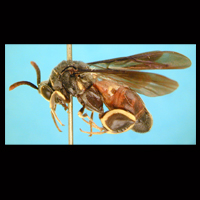About Leucospis




Leucospis are the charismatic megafauna of the Chalcidoidea. Specimens are large (up to 20 mm in length) and often brightly colored. They are strongly sclerotized, with the hind femora swollen and toothed and the wings can be folded longitudinally and the ovipositor is recurved over the metasoma.
Relationships: Leucospis is one of four genera belonging to the family Leucospidae (Hymenoptera: Chalcidoidea). In the past they have been placed as a subfamily of Chalcididae, but a phylogenetic analysis of Chalcididae (Wijesekara 1997) placed the leucospids as its sister group. Wijesekara (1997) provided seven unambiguous synapomorphies establishing the monophyly of Chalcididae excluding the leucospids.
The phylogenetic relationships of the four genera of Leucospidae have not been rigorously studied but is seems certain that Polistomorpha Westwood is a plesiomorphic genus (7 species from Central and South America) and that Neleucospis Boucek (1 species from southern Africa) and Micrapion Kriechbaumer (11 species from African and Madagascar) are apomorphic derivatives of Leucospis (Boucek 1974). Accordingly, understanding the phylogenetic relationships of the family Leucospidae will require a detailed understanding of species diversity and intrageneric affinities of the core genus Leucospis (114 species, worldwide in distribution, Noyes 2004).
The taxonomy of the leucospids was put on a firm foundation by the first only species level revision for a major family level taxon in the Chalcidoidea. (Boucek 1974). In addition to clarifying the nomenclature and taxonomy of Leucospis, Boucek also provided an intrageneric classification based on species groups: 15 species groups and 4 species sola were recognized.
This interactive identification key was prepared to test the utility
of the species group classification proposed in Boucek (1974) and to provide
an identification tool. The resultant key was then used to evaluate the
monophyly and relationships of the species groups of Leucospis
(Darling and Cardinal 2005).
As a result of this study, the pediculata species-group was divided
into two putatively monophyletic species-groups: the pediculata
species-group (revised composition) and micrura species-group.
Distribution: The genus Leucospis is worldwide
in distribution. Most species are confined to the warmer areas of the
world, but a few species are found in temperate areas.
Biology: Little is known of their biology, but all species for which host records are available (only 33 species) are ectoparasitoids of larval aculeate Hymenoptera. As noted by Boucek (1974), most leucospids resemble common species of wasps or bees found in their ranges, not necessarily their hosts.

